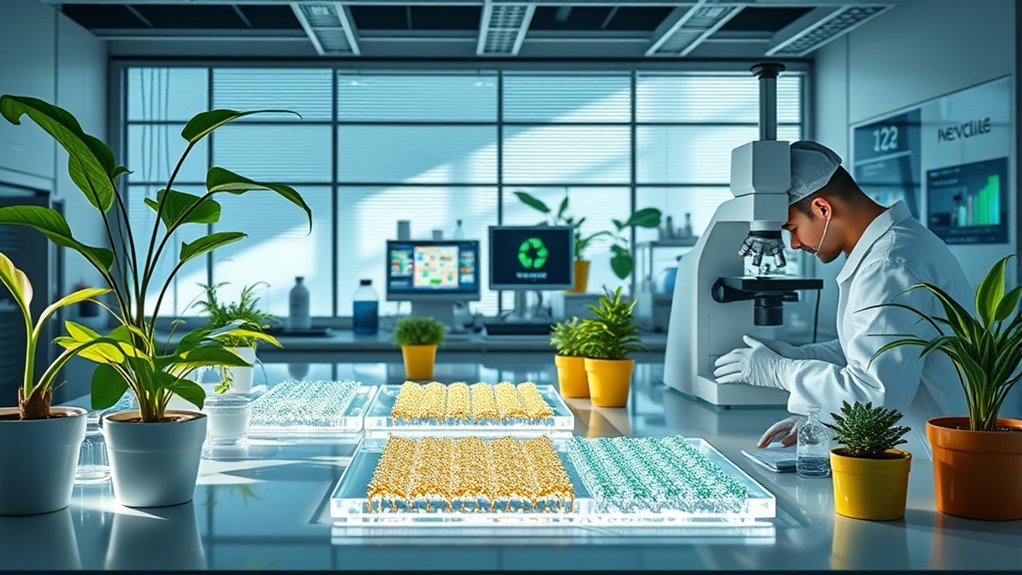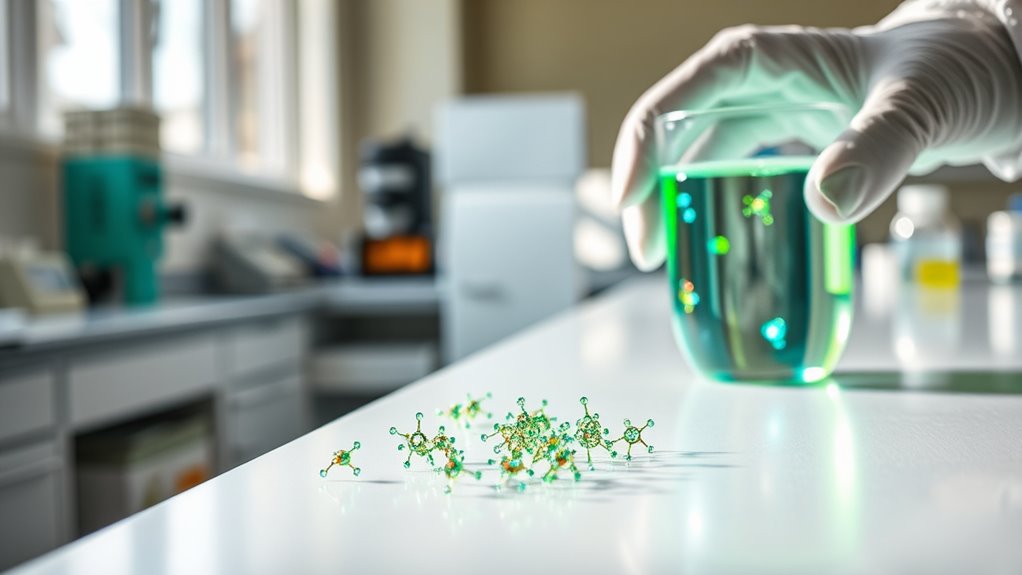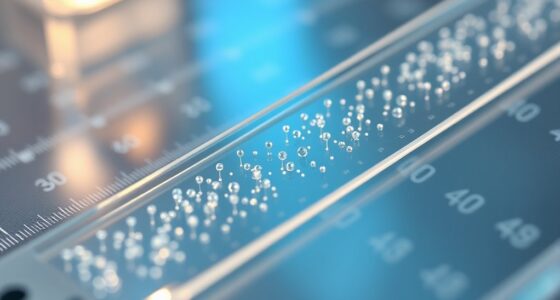Sustainability in Nano R&D involves using eco-friendly synthesis techniques that minimize harmful chemicals and energy use, helping you create safer, greener nanomaterials. By applying lifecycle assessments, you can analyze each stage from raw materials to disposal, identifying ways to reduce waste, emissions, and resource consumption. This responsible approach guarantees your innovations support environmental goals and public trust. Keep exploring to discover how integrating these strategies can enhance your sustainable nanotechnology projects.
Key Takeaways
- Incorporating eco-friendly synthesis methods minimizes environmental impact during nanomaterial production.
- Lifecycle assessment ensures sustainable practices by evaluating environmental impacts from raw materials to disposal.
- Sustainable Nano R&D promotes the use of green solvents, plant-derived agents, and energy-efficient processes.
- Responsible innovation in nanotechnology aligns performance goals with environmental and health safety standards.
- Integrating sustainability principles supports resource efficiency, pollution reduction, and regulatory compliance.

Have you ever wondered how nanotechnology can advance sustainability? It’s a fascinating area where scientists and engineers are pushing boundaries to create solutions that are both innovative and environmentally responsible. One vital aspect is eco friendly synthesis, which emphasizes developing methods to produce nanomaterials without harmful chemicals or excessive energy use. Instead of relying on toxic solvents or hazardous reagents, researchers are exploring greener alternatives such as water-based processes, plant-derived agents, or energy-efficient techniques. This shift not only reduces the environmental footprint during manufacturing but also aligns with the broader goals of sustainable development. By adopting eco friendly synthesis, you can help guarantee that nanomaterials are created with minimal impact on ecosystems and human health, making nanotechnology more compatible with our planet’s needs.
Eco friendly synthesis reduces nanomaterial impact through greener, safer manufacturing methods.
Another key element in sustainable nanotechnology is conducting a thorough lifecycle assessment. This process involves analyzing every stage of a nanomaterial’s life, from raw material extraction to disposal or recycling. By understanding the full lifecycle, you can identify potential environmental impacts and optimize processes to reduce waste, energy consumption, and emissions. Lifecycle assessment encourages designers and developers to think holistically, guaranteeing that the benefits of nanomaterials don’t come at an unsustainable cost. For example, it might reveal that a particular nanomaterial, while effective, requires significant energy during synthesis or produces hazardous waste. Armed with this knowledge, you can make informed decisions—perhaps choosing alternative materials or improving manufacturing efficiency—to promote sustainability.
Integrating eco friendly synthesis with lifecycle assessment creates a powerful framework for responsible innovation in nanotechnology. It allows you to develop materials that are not only high-performing but also aligned with environmental standards. This synergy helps mitigate risks associated with nanomaterials, such as toxicity or environmental accumulation, guaranteeing that their benefits do not lead to unintended harm. Furthermore, embracing these principles can foster public trust and regulatory support, as stakeholders increasingly demand sustainable practices in scientific research and industrial processes. Incorporating preppy dog names into branding strategies or product lines could also enhance consumer appeal by conveying a sense of sophistication and trustworthiness.
In essence, advancing sustainability in Nano R&D requires a proactive approach that combines green synthesis techniques with thorough lifecycle assessments. When you prioritize these strategies, you’re contributing to a future where nanotechnology enables solutions for clean energy, pollution control, and resource efficiency—all while respecting our planet’s ecological balance. This integration empowers you to innovate responsibly, guaranteeing that the remarkable potential of nanotechnology benefits society without compromising environmental integrity.
Frequently Asked Questions
How Do Nano Materials Impact Ecological Systems Long-Term?
You might wonder how nanomaterials affect ecological systems long-term. They can pose ecotoxicity risks if they accumulate or interact unpredictably with organisms. Conducting thorough ecotoxicity assessments helps identify potential hazards. However, biodegradability challenges mean many nanomaterials persist in environments, possibly harming ecosystems over time. Staying aware of these issues encourages responsible development and use, ensuring nanomaterials don’t cause unintended ecological damage in the future.
What Are Cost-Effective Sustainable Practices in Nano Manufacturing?
You can adopt cost-effective sustainable practices in nano manufacturing by utilizing green synthesis methods, which reduce the need for toxic chemicals and energy consumption. Additionally, focus on waste minimization strategies, like recycling process solvents and reusing unreacted materials, to cut costs and environmental impact. These approaches not only lower expenses but also promote eco-friendly manufacturing, ensuring your processes are sustainable and economically viable in the long run.
How Can Recycling of Nanomaterials Be Efficiently Achieved?
Did you know that recycling nanomaterials can reduce energy use by up to 50%? To achieve efficient nanomaterial recovery, you should focus on advanced recycling techniques like solvent-based separation and membrane filtration. These methods allow you to recover precious nanomaterials with minimal loss, making the process more sustainable. By optimizing these techniques, you can guarantee effective recycling and reduce environmental impact while maintaining material quality.
Are There Regulations Specific to Eco-Friendly Nano Research?
You’ll find that regulatory frameworks and eco labeling standards are increasingly establishing guidelines for eco-friendly nano research. These regulations aim to guarantee safe, sustainable practices by setting limits on nanomaterials’ environmental impact and promoting transparency. As a researcher, you should stay updated on these evolving rules to ensure compliance, adopt eco-friendly methods, and contribute to responsible innovation in nano R&D.
How Can Nano R&D Reduce Overall Environmental Footprints?
You can slash your environmental footprint by harnessing nano energy and green synthesis techniques, transforming what seems like tiny steps into giant leaps for sustainability. By optimizing nano energy, you maximize efficiency and reduce waste, while green synthesis minimizes hazardous chemicals and energy use. Together, these approaches make your nano R&D not just innovative but eco-friendly, turning small innovations into massive environmental benefits—like saving the planet one nano at a time.
Conclusion
As you navigate the future of Nano R&D, remember that embracing sustainability gently guides us toward harmonious innovation. By thoughtfully weaving eco-conscious practices into your work, you help nurture a world where tiny breakthroughs bloom within a caring, sustainable landscape. With each mindful step, you contribute to a brighter, more balanced tomorrow—where progress and nature coexist softly, like the quiet whisper of a future gently unfolding.








